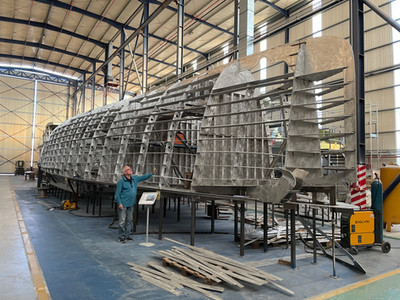An Established Yacht Design Presence for Extreme Passage Makers
- Chris Leigh-Jones
- Nov 26, 2022
- 3 min read
Updated: Mar 28, 2023
Innovation can be viral; ideas can spread without effort, especially if the audience is listening. The Dashews and their NZ yards held a flame by creating 18 extreme passage makers, all variations of FPB. Then it stopped. But good ideas are viral, and they tested many good ideas for others to build upon.
It is easy to "copy" a design, but in that act, you consign the business to forever being a Cinderella at the ball. It is another matter of "understanding" a concept, developing it to meet changing circumstances, and adapting to new technologies. Artnautica, led by Dennis Harjamaa, has achieved just that, and here is why.
Let us start firstly with the existence of a receptive audience. The illustration is a heat map illustrating unique visitors to our website, exploreryacht.com. Visitors are from N America, NW Europe, and Australasia. We also looked at this mapping for Setsail.com, the website for FPB; the heat maps are interchangeable for all practical purposes demonstrating that both have the same audience demographic. There are a few outliers; these are probably VPN (virtual private networks) pinging connections randomly around the world. This data is solid and evolving, you can even see Naval Yachts (Antalya), us (Bluffton SC), and probably a particular yard in Whangarei, NZ, but I can't prove it 100%. In viral terms, the interest is persistent and seemingly self-replicating.
Long narrow hulls of the initial 2 LRC-58 explorer Yachts from Artnautica.
Moving along to the designs. FPB is the product of a single team and yard; all 18 variants are currently sailing. From 20 through 34 meters and 40 through 130 metric Tonnes displacement. Artnautica designs are still incubating, with nine variations sailing or in build and five under contract negotiation. The range ranges from 18 to 26 meters and 15 to 60 tonnes.
Table 1 compares the physical characteristics of the Artnautica and FPB ranges. Figures are rounded and scraped from the internet, with no claims of accuracy!
At the lower end, you have the LRC designs, short sea capable craft of lighter weight scantlings but similar high Length to Beam ratio. At the bigger end, you have the XPM designs that are a close comparison to FPB with similar Coefficients and heavy-weight construction though slightly narrower and shallower hulls. A more detailed comparison of FPB-70 and XPM-78 can be found HERE.
Solid scantlings and increased hull shell plate thickness to resist the harsh realities of exploration. XPM-78, initial design concept drawings for hull No 1.
The point to note here, though, is over their 14 years or so production run, Circa Marine built a total of 18 hulls. Artnautica designs now number 14 hulls sailing, under construction, or negotiating a yard contract.
Illustration of the production run for Artnautica (14), and FPB (18) designs as of 2022.
The ranges are not identical, FPB's tend to favor the larger and heavier construction philosophy similar to XPM, while at the smaller end, the LRCs are light and nimble. Those light, nimble hulls can take advantage of technology and are increasingly investigating hybrid drives, twin engines, and battery centric rather than generator-centric systems.
Read also: XPM-78 - Designing the First Hull
Hull of the first XPM-85 under construction at Naval Yachts, close-up including a close-up of the 25mm aluminum stem plate and impact crumple zone. The character is Don Gregory, a ex seagoing Chartered Marine Engineer and long-time friend.
Hydrodynamics is science; as such, none of us are entitled to our personal facts, only opinions. Table (1) above lists some basic parameters for each hull. Length, draft, displacement, range. Unsurprisingly, the accurate picture is that these designs have similar hull speeds and ranges. Evolution has created similar designs by embracing the same philosophy of long, narrow, shallow draft hulls of seaworthy construction pursuing the same aim, sea handling, and range. The same reason a dolphin looks similar to a shark and a bat to a bird. Funny that.
So, in summary, it does look now like you can spell a successful extreme passage maker with a three-letter group - FPB, LRC, or XPM. It's all one and the same to those in the know.
Dennis Harjamaa - Artnautica NZ
Rob Westermann - Artnautica Europe
Chris Leigh-Jones























Comments